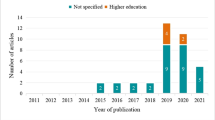Abstract
In this research, a method has been presented to predict the science production share of the Islamic Azad University in Iran at the end of 2017 and 2025 by artificial neural networks and adaptive network-based fuzzy inference systems. The used data were scientific publications under affiliations entitled “Azad University” or “University of Azad” gathered from Scopus databases. To build the model for training, testing and validation the network, scientific researches of the recent 24 years were extracted and used as inputs. The output of the obtained models was the science production share of the Islamic Azad University in scientific research of Iran. The built models showed an excellent potential to predict the science production share of the Islamic Azad University. A good fit equation that correlates the science production share of the Islamic Azad University in Iran to its number of publication at a specific year was presented. By extrapolation method, the scientific share of the Islamic Azad University among all of the Iranian’s scientific institutions was predicted equal to about 50 and 78% at the years 2017 and 2025, respectively.








Similar content being viewed by others
Change history
24 May 2021
A Correction to this paper has been published: https://doi.org/10.1007/s00521-021-06075-7
References
Armstrong JS, Sperry T (1994) Business school prestige: research versus teaching. Interfaces 24(2):13–33
Pala M, Ozbay O, Oztas A, Yuce MI (2005) Appraisal of long-term effects of fly ash and silica fume on compressive strength of concrete by neural networks. Construct Build Mater 21(2):384–394
Nazari A, Riahi S (2010) Computer-aided prediction of physical and mechanical properties of high strength cementitious composite containing Cr2O3 nanoparticles. NANO 5(5):301–318
Nazari A, Riahi S (2011) Prediction split tensile strength and water permeability of high strength concrete containing TiO2 nanoparticles by artificial neural network and genetic programming. Compos B Eng 42:473–488
Nazari A, Riahi S (2011) Computer-aided design of the effects of Fe2O3 nanoparticles on split tensile strength and water permeability of high strength concrete. Mater Des 32:3966–3979
Nazari A, Milani AA, Zakeri M (2011) Modeling ductile to brittle transition temperature of functionally graded steels by artificial neural networks. Comput Mater Sci 50:2028–2037
Jang JSR (1993) ANFIS: adaptive-network-based fuzzy inference system. IEEE Trans Syst Man Cyber 23(3):665–685
Sarıdemir M (2009) Predicting the compressive strength of mortars containing metakaolin by artificial neural networks and fuzzy logic. Adv Eng Soft 40(9):920–927
Ramezanianpour AA, Sobhani M, Sobhani J (2004) Application of network based neuro-fuzzy system for prediction of the strength of high strength concrete. Amirkabir J Sci Technol 5(59-C):78–93
Mukherjee A, Biswas SN (1997) Artificial neural networks in prediction of mechanical behavior of concrete at high temperature. Nucl Eng Design 178(1):1–11
Ince R (2004) Prediction of fracture parameters of concrete by artificial neural networks. Eng Fract Mech 71(15):2143–2159
McCulloch WS, Pitts W (1943) A logical calculus of the ideas immanent in neural nets. Bull Math Biophys 5:115–137
Rosenblatt F (1962) Principles of neuro dynamics: perceptrons and the theory of brain mechanisms. Spartan Books, Washington
Rumelhart DE, Hinton GE, William RJ (1986) Learning internal representation by error propagation. In: Rumelhart DE, McClelland JL (eds) Proceeding parallel distributed processing foundation, vol 1. MIT Press, Cambridge
Liu SW, Huang JH, Sung JC, Lee CC (2002) Detection of cracks using neural networks and computational mechanics. Comput Meth Appl Mech Eng 191(25–26):2831–2845
Hopfield JJ (1982) Neural networks and physical systems with emergent collective computational abilities. Proc Nat Acad Sci 79:2554–2558
Suratgar AA, Tavakoli MB, Hoseinabadi A (2005) Modified Levenberg–Marquardt method for neural networks training. World Acad Sci Eng Technol 6:46–48
Guzelbey IH, Cevik A, Erklig A (2006) Prediction of web crippling strength of cold-formed steel sheetings using neural networks. J Constr Steel Res 62:962–973
Guzelbey IH, Cevik A, Gögüs MT (2006) Prediction of rotation capacity of wide flange beams using neural networks. J Constr Steel Res 62:950–961
Cevik A, Guzelbey IH (2008) Neural network modeling of strength enhancement for Cfrp confined concrete cylinders. Build Environ 43:751–763
Cevik A, Guzelbey IH (2007) A soft computing based approach for the prediction of ultimate strength of metal plates in compression. Eng Struct 29(3):383–394
Sarıdemir M (2009) Prediction of compressive strength of concretes containing metakaolin and silica fume by artificial neural networks. Adv Eng Softw 40:350–355
Ramezanianpour AA, Sobhani J, Sobhani M (2004) Application of an adaptive neurofuzzy system in the prediction of HPC compressive strength. In: Proceedings of the fourth international conference on engineering computational technology. Civil-Comp Press, Lisbon, p 138
Topcu IB, Sarıdemir M (2008) Prediction of mechanical properties of recycled aggregate concretes containing silica fume using artificial neural networks and fuzzy logic. Comp Mater Sci 42(1):74–82
Author information
Authors and Affiliations
Corresponding author
About this article
Cite this article
Nazari, A. RETRACTED ARTICLE: The role of the Islamic Azad University in science production of Iran: from the past to the future. Neural Comput & Applic 23, 311–322 (2013). https://doi.org/10.1007/s00521-012-0898-1
Received:
Accepted:
Published:
Issue Date:
DOI: https://doi.org/10.1007/s00521-012-0898-1




